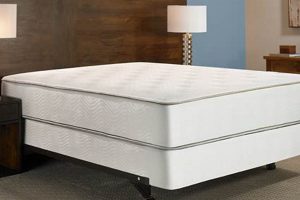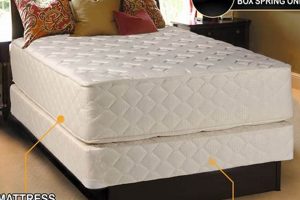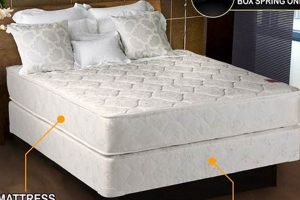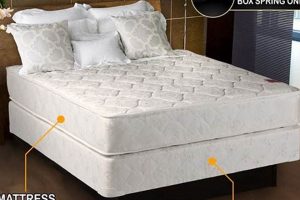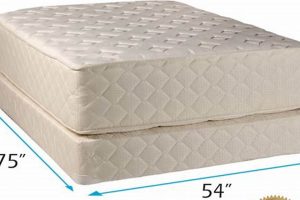Sleeping surfaces designed for direct placement on a bed frame or the floor eliminate the requirement for a traditional box spring. These designs often incorporate internal support structures robust enough to distribute weight evenly and maintain structural integrity without additional foundation support. Platform beds, adjustable beds, and certain types of metal bed frames are commonly used with these mattresses.
The absence of a box spring can offer several advantages. It contributes to a lower overall bed height, which can be beneficial for individuals with mobility challenges or those preferring a more modern, minimalist aesthetic. Furthermore, eliminating the box spring can reduce costs and simplify setup. Historically, box springs were essential for providing both support and shock absorption to innerspring mattresses. However, advancements in mattress technology, particularly with foam and hybrid constructions, have led to designs capable of providing adequate support independently.
This development has facilitated a wider range of bed frame options and design possibilities. Understanding the structural characteristics of different mattress types becomes crucial when selecting a sleeping surface that doesn’t rely on a box spring. The following sections will delve into the various types of these mattresses, their specific advantages, and considerations for choosing the optimal model.
Tips for Selecting a Mattress That Doesn’t Need a Box Spring
Choosing a sleeping surface designed for use without a box spring requires careful consideration. Prioritize factors such as mattress type, support system, and compatibility with the bed frame to ensure optimal comfort and longevity.
Tip 1: Research Mattress Types: Memory foam, latex, and hybrid mattresses often offer sufficient support without a box spring. Understanding the unique characteristics of each material is crucial. For example, memory foam contours to the body, while latex provides a more responsive feel.
Tip 2: Evaluate Support Systems: Inquire about the mattress’s internal support system. Look for features such as high-density foam cores or individually wrapped coils. These elements contribute to even weight distribution and minimize sagging, particularly in the absence of a box spring.
Tip 3: Check Bed Frame Compatibility: Ensure the chosen mattress is compatible with the existing bed frame. Platform beds with closely spaced slats provide adequate support. Adjustable bases are also designed for use without a box spring. Metal frames should have sufficient center support to prevent mattress deformation.
Tip 4: Consider Edge Support: Mattresses lacking a box spring may exhibit less edge support. Examine models with reinforced edges to prevent roll-off and maximize the usable sleeping surface.
Tip 5: Read Customer Reviews: Consult customer reviews for insights into the mattress’s long-term performance and durability without a box spring. Pay attention to comments regarding support, comfort, and potential issues.
Tip 6: Assess Weight Capacity: Verify that the mattress can adequately support the weight of the intended occupants. Exceeding the weight capacity can compromise the mattress’s structural integrity and shorten its lifespan.
Tip 7: Factor in Sleeping Position: Different sleeping positions require varying levels of support. Side sleepers may benefit from a softer mattress that conforms to the body, while back and stomach sleepers may prefer a firmer option.
Selecting a mattress specifically designed for use without a box spring involves careful consideration of material composition, support structure, and bed frame compatibility. Adhering to these guidelines ensures a comfortable, supportive, and durable sleep surface. Further investigation into specific mattress features and retailer policies is recommended before making a final decision.
The next section will explore common mistakes to avoid when purchasing a “mattress that doesn’t need a box spring.”
1. Support structure
The integral nature of the support structure within a mattress dictates its independence from a box spring. Mattresses designed for use without a box spring rely entirely on their internal construction to provide adequate support, weight distribution, and spinal alignment. Consequently, the design and quality of this support structure are paramount. For instance, a high-density foam core, strategically layered foam densities, or an advanced pocketed coil system are all examples of internal support mechanisms that enable a mattress to function effectively without external foundation support. Conversely, a mattress with a weak or poorly designed internal structure will likely sag prematurely, compromising comfort and potentially leading to musculoskeletal issues.
The specific type of support structure varies significantly depending on the mattress type. Memory foam mattresses often employ a dense foam base layer for foundational support, while hybrid mattresses typically utilize a combination of coils and foam layers. Latex mattresses may rely on the inherent resilience of the latex material itself for support. Consider the example of a high-end hybrid mattress. Its internal structure could comprise a layer of individually wrapped coils to minimize motion transfer, followed by layers of memory foam and latex for comfort and pressure relief. This sophisticated design negates the need for a box spring by providing zoned support and contouring to the body’s unique shape.
Therefore, when selecting a mattress designed for use without a box spring, careful consideration must be given to the internal support structure. Evaluating the density and arrangement of materials, as well as the overall design, is crucial for ensuring long-term comfort and support. Compromising on support structure quality often results in premature mattress degradation and the eventual need for a box spring, thereby negating the intended benefits of a “mattress that doesn’t need a box spring.”
2. Frame compatibility
Frame compatibility is a critical consideration when selecting a mattress designed for use without a box spring. The absence of a traditional box spring necessitates that the bed frame itself provides adequate support and weight distribution. Incompatible frame designs can compromise the mattress’s structural integrity, leading to premature sagging, uneven wear, and diminished comfort. For example, a mattress placed directly on a frame with widely spaced slats may experience localized stress points, resulting in deformation over time. Conversely, a solid platform bed or a closely slatted frame provides a stable and even surface, effectively supporting the mattress and preserving its intended performance characteristics.
The type of bed frame significantly influences the overall effectiveness of a box spring-free mattress system. Platform beds, adjustable bases, and certain metal frames are specifically engineered to support mattresses directly. Platform beds, characterized by a solid or closely slatted surface, offer optimal support. Adjustable bases, commonly used with memory foam and latex mattresses, provide customizable support and positioning without requiring a box spring. Metal frames, however, must be assessed for adequate center support to prevent mattress bowing or sagging. The frame material, slat spacing, and the presence of a center support beam are all crucial elements in determining compatibility.
Understanding frame compatibility is essential for maximizing the lifespan and performance of a mattress intended for use without a box spring. Choosing an incompatible frame can negate the benefits of a high-quality mattress, leading to discomfort and premature replacement. Therefore, thorough evaluation of the bed frame’s structural design and support capabilities is paramount. It is advisable to consult the mattress manufacturer’s recommendations regarding compatible frame types to ensure optimal performance and longevity, and to avoid voiding any existing warranties.
3. Mattress height
Mattress height assumes particular significance when the sleeping surface is intended for use without a box spring. In these configurations, the mattress itself provides the total vertical dimension of the sleep system, influencing accessibility, aesthetic appeal, and overall comfort. The interplay between mattress height and frame design dictates the final bed height, with implications for various users and room aesthetics.
- Accessibility Considerations
Mattress height directly affects ease of access to the bed, particularly for individuals with mobility limitations. A lower mattress height, achieved by combining a thinner mattress with a low-profile frame, can facilitate easier entry and exit. Conversely, a thicker mattress on the same frame results in a higher bed, which may pose challenges for some users. For example, elderly individuals or those recovering from surgery may find a lower bed height more manageable. The ideal mattress height, therefore, depends on the user’s physical capabilities and personal preferences.
- Aesthetic Implications
The vertical dimension of the mattress contributes significantly to the overall aesthetic of the bedroom. A thicker mattress can create a more luxurious and substantial appearance, while a thinner mattress promotes a minimalist, modern aesthetic. In rooms with lower ceilings, a thinner mattress may be preferable to maintain a sense of spaciousness. The choice of mattress height should complement the existing room decor and personal design preferences. The impact of mattress height on the perceived visual weight of the bed should be carefully considered during the selection process.
- Support and Comfort
While mattress height is not a direct indicator of support or comfort, it can influence the design and composition of the internal support layers. Thicker mattresses often incorporate more layers of comfort materials, such as memory foam or latex, potentially enhancing pressure relief and overall sleep quality. However, a thinner mattress can still provide adequate support and comfort if it utilizes high-density materials and a well-engineered internal structure. It is essential to evaluate the specific materials and construction techniques, rather than solely relying on mattress height as a measure of quality.
- Frame Compatibility and Support
Mattress height can impact the distribution of weight and the degree of support provided by the bed frame. A thicker mattress may require a more robust frame to ensure adequate support and prevent sagging. Conversely, a thinner mattress may be suitable for use with a less substantial frame. The frame’s slat spacing, material strength, and the presence of a center support beam are all critical factors to consider. Incompatible frame designs can compromise the mattress’s performance and longevity, regardless of its height.
The consideration of mattress height is an integral component of selecting a sleeping surface designed for use without a box spring. Accessibility, aesthetics, support characteristics, and frame compatibility are all interconnected factors that must be carefully evaluated. By understanding the interplay between these elements, individuals can make informed decisions and optimize their sleep environment. Further investigation of specific mattress types and their corresponding height profiles is recommended to align with individual needs and preferences.
4. Material density
Material density is a critical determinant of performance in mattresses designed for use without a box spring. It directly influences the support, durability, and overall longevity of the sleep surface, compensating for the absence of a traditional foundation.
- Support and Weight Distribution
Higher material density provides superior support and weight distribution. Dense foams, for example, resist compression and prevent sagging, ensuring consistent spinal alignment. A high-density memory foam mattress, unlike its low-density counterpart, will maintain its shape and support over time, even when subjected to significant weight. This is especially crucial in the absence of a box spring, where the mattress bears the entire load.
- Durability and Longevity
Increased density translates to enhanced durability and a prolonged lifespan. Dense materials are less susceptible to wear and tear, compression, and deformation. A high-density latex mattress, for instance, will outlast a low-density innerspring mattress, retaining its comfort and support characteristics for an extended period. This durability is a significant advantage for mattresses lacking a box spring, as they must withstand continuous pressure and use without the additional support of a foundation.
- Edge Support and Stability
Material density contributes significantly to edge support and overall stability. Dense materials provide a firmer edge, preventing roll-off and maximizing the usable sleep surface. Mattresses with high-density foam encasement offer enhanced edge support, particularly important in designs without a box spring, as they rely solely on their internal structure for stability.
- Impact on Motion Isolation
The density of the material plays an important role in absorbing movements, preventing it from spreading across the surface. For instance, a high-density memory foam mattress can greatly minimize motion transfer from one side of the bed to the other. This is crucial in mattresses without a box spring for undisturbed sleep.
In conclusion, material density is a pivotal factor in evaluating mattresses designed for use without a box spring. It directly impacts support, durability, edge support, and motion isolation, ultimately influencing the overall comfort and longevity of the sleep system. Selecting mattresses with high-density materials is therefore a prudent decision for those seeking a long-lasting and supportive sleep surface without the need for a traditional foundation.
5. Edge support
Edge support is a significant factor in the overall performance of mattresses designed for use without a box spring. Without the traditional foundation to provide peripheral reinforcement, the mattress’s edge construction becomes critical for stability, usability, and longevity.
- Prevention of Roll-Off
Strong edge support mitigates the risk of roll-off, particularly for individuals who sleep near the edge of the bed or require assistance getting in and out. Mattresses lacking adequate edge support may compress significantly under pressure, leading to a sensation of instability and potential falls. Reinforced edges, often achieved through high-density foam encasements or specialized coil designs, provide a more stable and secure sleeping surface.
- Maximization of Usable Surface Area
Effective edge support maximizes the usable sleeping surface of the mattress. Without it, the perimeter of the mattress may become unusable due to excessive compression and a sloping effect. This is particularly relevant for smaller mattresses or for couples sharing a bed. Robust edge support ensures that the entire surface area of the mattress provides consistent support and comfort, allowing individuals to fully utilize the available space.
- Structural Integrity and Longevity
Edge support contributes to the overall structural integrity and longevity of the mattress. By preventing excessive compression and deformation along the edges, it helps to maintain the mattress’s shape and support characteristics over time. Mattresses with weak edge support are more prone to sagging and breakdown, especially along the perimeter, which can compromise the overall comfort and performance of the sleep system.
- Enhancement of Sitting Comfort
Strong edge support enhances sitting comfort along the edge of the bed. This is particularly beneficial for individuals who use the edge of the bed for activities such as reading, dressing, or simply sitting down. Mattresses with robust edge support provide a stable and comfortable seating surface, preventing excessive compression and discomfort. This feature is often overlooked but can significantly improve the overall usability and enjoyment of the mattress.
The presence of effective edge support is a critical factor in determining the suitability of a mattress designed for use without a box spring. It directly impacts stability, usability, longevity, and overall comfort, compensating for the absence of traditional foundation support. Selecting mattresses with reinforced edges is, therefore, essential for ensuring a durable and supportive sleep surface.
6. Longevity
The longevity of a mattress designed for use without a box spring is a primary consideration for consumers seeking a durable and cost-effective sleep solution. Without the shock-absorbing and support-enhancing qualities of a traditional box spring, these mattresses must possess inherent structural integrity and material resilience to withstand prolonged use and maintain their intended performance characteristics.
- Material Quality and Density
The quality and density of materials directly influence a mattress’s lifespan. High-density foams, for instance, resist compression and deformation more effectively than low-density alternatives. A mattress constructed with high-quality latex or memory foam is more likely to retain its shape and support properties over time, mitigating premature sagging and extending its overall lifespan. The choice of materials represents a critical factor in determining long-term durability.
- Construction and Design
The construction techniques employed in the mattress significantly impact its ability to withstand wear and tear. Reinforced edges, robust stitching, and a well-engineered internal support system contribute to structural integrity and prevent premature breakdown. Mattresses with a thoughtfully designed construction are better equipped to distribute weight evenly and resist the effects of prolonged use, leading to a longer lifespan. Poor construction, conversely, can lead to localized stress points and accelerated degradation.
- Support System Durability
The durability of the internal support system, whether composed of coils, foam, or a hybrid configuration, is crucial for maintaining long-term support and comfort. High-quality coils, individually wrapped to minimize motion transfer, are less prone to sagging and deformation than traditional innerspring systems. Similarly, dense foam cores with strategically placed support zones provide consistent and reliable support over extended periods. The resilience of the support system is paramount in ensuring the mattress retains its intended shape and firmness.
- Proper Maintenance and Usage
Even the most durable mattress benefits from proper maintenance and usage. Regular rotation and flipping (if applicable) help to distribute wear evenly and prevent localized compression. The use of a mattress protector safeguards against spills, stains, and allergens, extending the mattress’s lifespan and maintaining its hygienic properties. Adhering to manufacturer guidelines regarding weight limits and suitable bed frames also contributes to long-term performance and prevents premature wear.
The longevity of a “mattress that doesn’t need a box spring” hinges on a confluence of factors, including material quality, construction techniques, support system durability, and proper maintenance. Selecting a mattress with high-density materials, a robust design, and a durable support system, coupled with diligent care and usage, maximizes the likelihood of achieving a long-lasting and comfortable sleep experience. The absence of a box spring necessitates a heightened emphasis on these factors to ensure the mattress retains its intended performance characteristics over time.
Frequently Asked Questions About Mattresses That Don’t Need a Box Spring
The following questions address common concerns and misconceptions regarding mattresses designed for use without a traditional box spring, providing clarity and guidance for informed decision-making.
Question 1: What types of mattresses are suitable for use without a box spring?
Memory foam, latex, and hybrid mattresses are generally suitable for use without a box spring. These mattress types often incorporate internal support structures capable of providing adequate support and weight distribution without a foundation.
Question 2: Will using a mattress without a box spring void the warranty?
It depends on the specific mattress manufacturer’s warranty policy. Some warranties require the use of a box spring for full coverage, while others are valid regardless of whether a box spring is used. Always consult the warranty documentation before using a mattress without a box spring.
Question 3: What type of bed frame is best for a mattress without a box spring?
Platform beds with closely spaced slats, adjustable bases, and certain metal frames with adequate center support are generally recommended for use with mattresses lacking a box spring. The frame must provide sufficient support to prevent sagging and maintain the mattress’s structural integrity.
Question 4: How does the absence of a box spring affect mattress height?
The absence of a box spring reduces the overall bed height, which can be advantageous for individuals with mobility limitations or those preferring a lower profile. Consider mattress thickness when determining the desired bed height.
Question 5: Does using a mattress without a box spring affect its level of support?
If the mattress is specifically designed for use without a box spring and is placed on a compatible bed frame, support should not be compromised. These mattresses often incorporate enhanced internal support systems to compensate for the absence of a foundation.
Question 6: Are there any disadvantages to using a mattress without a box spring?
Potential disadvantages include reduced edge support in some models and the need for a compatible bed frame to ensure adequate support. Carefully consider these factors when selecting a mattress that doesn’t require a box spring. Some individuals also prefer the added height and shock absorption provided by a traditional box spring.
In summary, choosing a mattress specifically designed for use without a box spring requires careful consideration of mattress type, frame compatibility, and warranty implications. Selecting the appropriate mattress and frame combination is essential for ensuring a comfortable and supportive sleep experience.
The following section will provide insights into common mistakes to avoid when purchasing a “mattress that doesn’t need a box spring.”
Conclusion
The preceding exploration has illuminated the multifaceted nature of a “mattress that doesn’t need a box spring.” From examining essential structural components like support systems and material density to outlining crucial considerations such as frame compatibility and longevity, the analysis underscores the importance of informed decision-making. The ability of these mattresses to deliver adequate support and comfort in the absence of a traditional foundation relies heavily on inherent design characteristics and careful selection of complementary bed frames. Key advantages include simplified setup, potentially lower costs, and a reduction in overall bed height, catering to diverse needs and aesthetic preferences.
Ultimately, the selection of a “mattress that doesn’t need a box spring” represents an investment in long-term sleep quality and overall well-being. Consumers are encouraged to meticulously evaluate individual needs, thoroughly research available options, and prioritize mattresses engineered for lasting support and durability. This proactive approach ensures the chosen sleep surface delivers consistent comfort and contributes positively to a restful and restorative sleep environment.


![Best King Size Box Mattress [Deals] - Sleep Like a King! Organic & Natural Mattress Buyer’s Guide: Non-Toxic Sleep Solutions Best King Size Box Mattress [Deals] - Sleep Like a King! | Organic & Natural Mattress Buyer’s Guide: Non-Toxic Sleep Solutions](https://mattressworldpa.com/wp-content/uploads/2025/07/th-3325-300x200.jpg)
